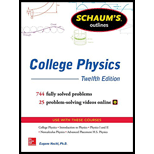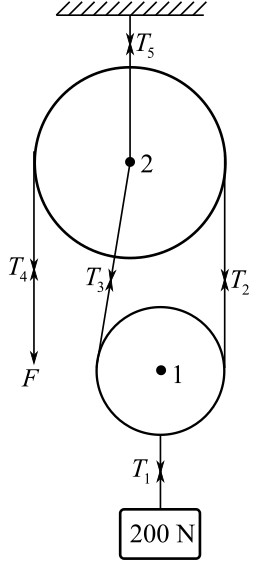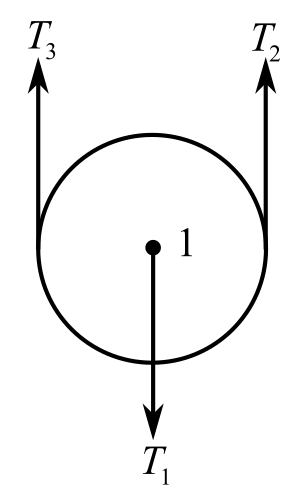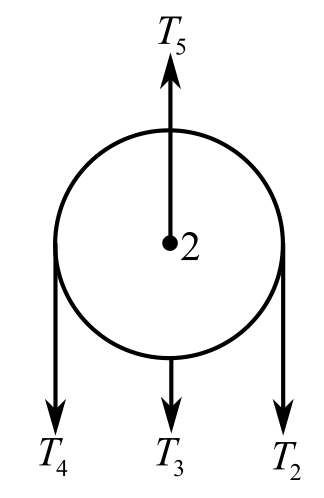
Concept explainers
The load in Fig. 4-7 is hanging at rest. Take the ropes to all be vertical and the pulleys to be weightless and frictionless. (a) How many segments of rope support the combination of the lower pulley and load? (b) What is the downward force on the lowest pulley (the “floating” one)? (c) What must be the total upward force exerted on the floating pulley by the two lengths of rope? (d) What is the upward force exerted on the floating pulley by each length of rope supporting it? (e) What is the tension in the rope wound around the two pulleys? (f) How much force is the man exerting? (g) What is the net downward force acting on the uppermost pulley? (h) How much force acts downward on the hook in the ceiling?
(a)
The segments of the rope that support the combination of the lower pulley given inFigure
Answer to Problem 16SP
Solution:
Explanation of Solution
Given data:
The weight of the hanging block is
The load is hanging on rest, so there will be no acceleration.
Formula used:
Write the expression for the first condition of the force’s equilibrium:
Here,
Explanation:
Draw the free body diagram of the system:

In the above diagram, point
Since the same rope is passing over theupper pulleyand lower pulley, the magnitude of tensionthroughout the rope should be same. Therefore,
Refer to the above diagram and consider the pulley 1. In this case,
Consider the upward forces as positive and the downward forces as negative. Therefore,
Substitute
Conclusion:
Therefore, two segments of the rope support the combination of the lower pulley and load.
(b)
The magnitude of the downward force applied to the lowest pulleyin the Figure
Answer to Problem 16SP
Solution:
Explanation of Solution
Given data:
The load is
The load is hanging on rest, so there will be no acceleration.
Formula used:
Write the expression for the first condition of the force’s equilibrium:
Here,
Explanation:
Draw the free body diagram when

Recall the expression for the first condition of the force’s equilibrium:
Consider the direction of the upward forces is positive and the direction of the downward forces is negative. Therefore,
Substitute
The tension forces of 200 N, acting in the rope, pule the load in upward direction and weight of the
Conclusion:
Therefore, the magnitude of the downward force on the lowest pulley is
(c)
The magnitude of the total upward force exertedon the floating pulley by the two lengths of ropein the Figure
Answer to Problem 16SP
Solution:
Explanation of Solution
Given data:
The load is
The load is hanging on rest, so there will be no acceleration.
Formula used:
Write the expression for the first condition of the force’s equilibrium:
Here,
Explanation:
Draw the free body diagram of the lowermost pulley:

Recall the expression for the first condition of the force equilibrium:
Consider the direction of the upward forces is positive and the direction of the downward forces is negative. Hence,
Substitute
Conclusion:
The magnitude of the total upward force applied on the pulley by the two lengths of the rope is
(d)
The magnitude of the upward force applied on the floating pulley by each length of rope supporting the pulleyin the figure
Answer to Problem 16SP
Solution:
Explanation of Solution
Given data:
The weight of the person is
The load is hanging on rest, so there will be no acceleration.
Formula used:
Write the expression for the first condition of the force’s equilibrium:
Here,
Explanation:
Draw the free body diagram of the lowermost pulley:

Recall the expression for the first condition of the force’s equilibrium:
Consider the direction of the upward forces is positive and the direction of the downward forces is negative. Hence,
Substitute
Conclusion:
The magnitude of the upward force applied on the floating pulley by each length of the rope is
(e)
The magnitude of the tensionin the rope wound around the two pulleysin the Figure
Answer to Problem 16SP
Solution:
Explanation of Solution
Given data:
The load is
The load is hanging on rest, so there will be no acceleration.
Formula used:
Write the expression for the first condition of the force’s equilibrium:
Here,
Explanation:
Refer to the diagram drawn in the subpart (a). A single rope is wounded on the both the polis. So, the magnitude of tension should be same throughout the rope. Therefore,
Substitute
Conclusion:
The magnitude of the tension in the rope wound around the pulley is
(f)
The maximum force applied by the man to pull the ropein the Figure
Answer to Problem 16SP
Solution:
Explanation of Solution
Given data:
The load is
The load is hanging on rest, so there will be no acceleration.
Formula used:
Write the expression for the first condition of the force’s equilibrium:
Here,
Explanation:
Draw the free body diagram of the unwound rope, which is in the right side of the upper pulley, when a man exerts a force F to pull the rope.

To observed the schematic diagram of the problem,
The force
Recall the expression for the first condition of the force’s equilibrium:
Consider the direction of the upward forces is positive and the direction of the downward forces is negative. Hence,
Substitute
Conclusion:
The magnitude of the maximum force applied by the man is
(g)
The magnitude of the net downward force acting on the uppermost pulleyin the Figure
Answer to Problem 16SP
Solution:
Explanation of Solution
Given data:
The load is
The load is hanging on rest, so there will be no acceleration.
Formula used:
Write the expression for the first condition of the force’s equilibrium:
Here,
Explanation:
Draw the free body diagram of the upper pulley:

Recall the expression for the first condition of the force’s equilibrium:
Consider the direction of the upward forces is positive and the direction of the downward forces is negative. Hence,
Substitute
The net downward force acting on the uppermost pulleyhas the same magnitude as the tension of the rope, which is
Conclusion:
Therefore, the total downward force acting on the upper pulley is
(h)
The maximum force that is acting downward on the hook in the ceilingin the Figure
Answer to Problem 16SP
Solution:
Explanation of Solution
Given data:
The load is
The load is hanging on rest, so there will be no acceleration.
Formula used:
Write the expression for the first condition of the force’s equilibrium:
Here,
Explanation:
Refer to the schematic diagram of the problem from the subpart (a).
The maximum force applied downward on the hook in the ceiling is equal to the same magnitude of the tension
Conclusion:
Therefore, themaximum force applied downward on the hook in the ceilingis
Want to see more full solutions like this?
Chapter 4 Solutions
Schaum's Outline of College Physics, Twelfth Edition (Schaum's Outlines)
Additional Science Textbook Solutions
Essential University Physics: Volume 1 (3rd Edition)
Fundamentals Of Thermodynamics
Conceptual Physical Science (6th Edition)
Physics for Scientists and Engineers
- (a) What is the maximum frictional force in the knee joint of a person who supports 66.0 kg of her mass on that knee? (b) During strenuous exercise, it is possible to exert forces to the joints that are easily 10 times greater than the weight being supported. What is the maximum force of friction under such conditions? The frictional forces in joints are relatively small in all circumstances except when the joints deteriorate, such as from injury or arthritis. Increased frictional forces can cause further damage and pain.arrow_forwardA 10-lb block B rests as shown on a 20-lb bracket A. The coefficients of friction are μs= 0.30 and uk = 0.25 between block B and bracket A , and there is no friction in the pulley or between the bracket and the horizontal surface. (a) Determine the maximum weight of block C if block B is not to slide on bracket A.(b) If the weight of block C is 10 percent larger than the answer found in a, determine the accelerations of A, B, and C.arrow_forwardA force of 600 N is applied on a block of mass M to pull it at a constant velocity up the incline at an angle of 30degrees with the horizontal. The coefficient of kinetic friction between the surface of the incline and the block is 0.5. Calculate the mass of the block.arrow_forward
- A rope exerts a force of 50 N on a box to keep it stationary. If the box is on a plane inclined 25° from the horizontal and the coefficient of static friction is 0.29, calculate the normal force exerted on the box.arrow_forwardA bedroom bureau with a mass of 45 kg, including drawers and clothing, rests on the floor. (a) If the coefficient of static friction between the bureau and the floor is 0.45, what is the magnitude of the minimum horizontal force that a person must apply to start the bureau moving? (b) If the drawers and clothing, with 17 kg mass, are removed before the bureau is pushed, what is the new minimum magnitude?arrow_forwardA frictionless ramp is tilted 40 degrees above the horizontal and has a 15 kg block placed on it. (a) What is the force normal of the ramp on the brick? (b) Would the answer change if the ramp was not frictionless?arrow_forward
- A boxweighing 150 lb is moved across a horizontal floor by dragging it means of a rope attached to the front end. If the rope makesan angle of 30 ̊with the floor and if the coefficient of friction between box and floor is 0.4, find the force exerted by the man pulling the rope.arrow_forwardLogs weighing 1.3 kg and 2.2 kg lie on a flat surface and are connected by a rope that breaks at a force of 20 N. The coefficient of friction between the lighter log and the base is 0.50, and between the heavier log and the base 0.30. With what maximum force can we pull the lighter log so that the string does not break?arrow_forwardA 10-kg weight is suspended by a rope from a ceiling. If a horizontal force of 5.80 kg is applied to the weight, the rope will make an angle with the vertical equal to:arrow_forward
- Suppose you have a 100-kg box full of books resting on a wood floor, with coefficient of static friction 0.500 between these surfaces. A force is applied at an angle of 30° with respect to the horizontal, as shown. M (a) What is the minimum force would you need to exert on the box to get it to move? (b) If you continue to exert this force once the box starts to slip, what will be its acceleration? The coefficient of sliding friction is known to be 0.300 for this situation.arrow_forward(ex) Two masses, pulley, incline with friction, static vs. kinetic friction: The two blocks shown below are connected by a light string over a massless frictionless pulley. The coefficient of static friction between each block and surface is 0.35, and the coefficient of kinetic friction is 0.20. The mass of block A is 10.0 kg, and the mass of block B is unknown. The angle of the incline is 30 degrees. Do everything in symbols first substitute numbers in only at the end. (See PSL 5.5,7,8,9) a) The blocks are released from rest, and they are on the verge of sliding, but they do not move. Draw FBDs for each block. b) In symbols, solve for the mass of block B. (What else could you solve for?) c) Substitute the numbers to determine the mass of block B. A 0 Barrow_forwardIf the coefficient of kinetic friction, , between the block and the surface is 0.30 and the magnitude of the frictional force is 80.0 N, what is the weight of the block? ( Assume the block is on a horizontal surface)arrow_forward
 College PhysicsPhysicsISBN:9781305952300Author:Raymond A. Serway, Chris VuillePublisher:Cengage Learning
College PhysicsPhysicsISBN:9781305952300Author:Raymond A. Serway, Chris VuillePublisher:Cengage Learning University Physics (14th Edition)PhysicsISBN:9780133969290Author:Hugh D. Young, Roger A. FreedmanPublisher:PEARSON
University Physics (14th Edition)PhysicsISBN:9780133969290Author:Hugh D. Young, Roger A. FreedmanPublisher:PEARSON Introduction To Quantum MechanicsPhysicsISBN:9781107189638Author:Griffiths, David J., Schroeter, Darrell F.Publisher:Cambridge University Press
Introduction To Quantum MechanicsPhysicsISBN:9781107189638Author:Griffiths, David J., Schroeter, Darrell F.Publisher:Cambridge University Press Physics for Scientists and EngineersPhysicsISBN:9781337553278Author:Raymond A. Serway, John W. JewettPublisher:Cengage Learning
Physics for Scientists and EngineersPhysicsISBN:9781337553278Author:Raymond A. Serway, John W. JewettPublisher:Cengage Learning Lecture- Tutorials for Introductory AstronomyPhysicsISBN:9780321820464Author:Edward E. Prather, Tim P. Slater, Jeff P. Adams, Gina BrissendenPublisher:Addison-Wesley
Lecture- Tutorials for Introductory AstronomyPhysicsISBN:9780321820464Author:Edward E. Prather, Tim P. Slater, Jeff P. Adams, Gina BrissendenPublisher:Addison-Wesley College Physics: A Strategic Approach (4th Editio...PhysicsISBN:9780134609034Author:Randall D. Knight (Professor Emeritus), Brian Jones, Stuart FieldPublisher:PEARSON
College Physics: A Strategic Approach (4th Editio...PhysicsISBN:9780134609034Author:Randall D. Knight (Professor Emeritus), Brian Jones, Stuart FieldPublisher:PEARSON





